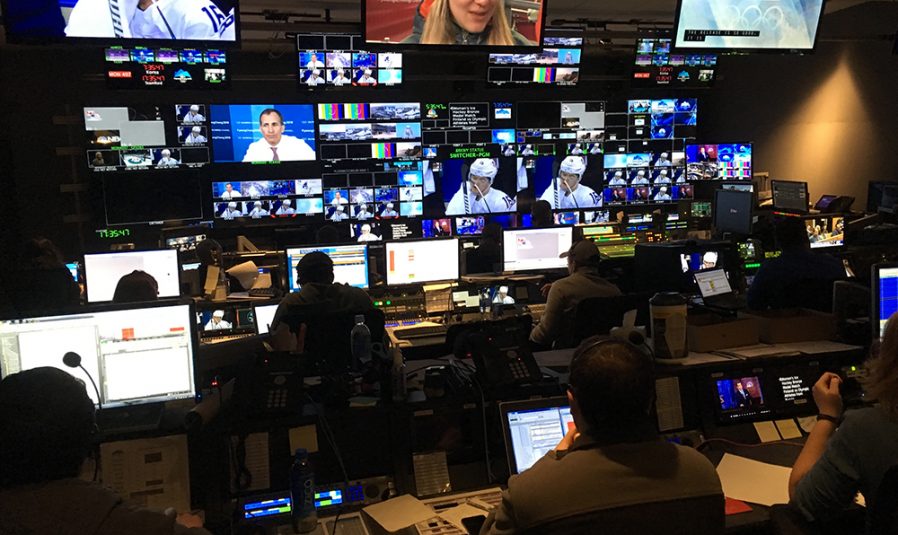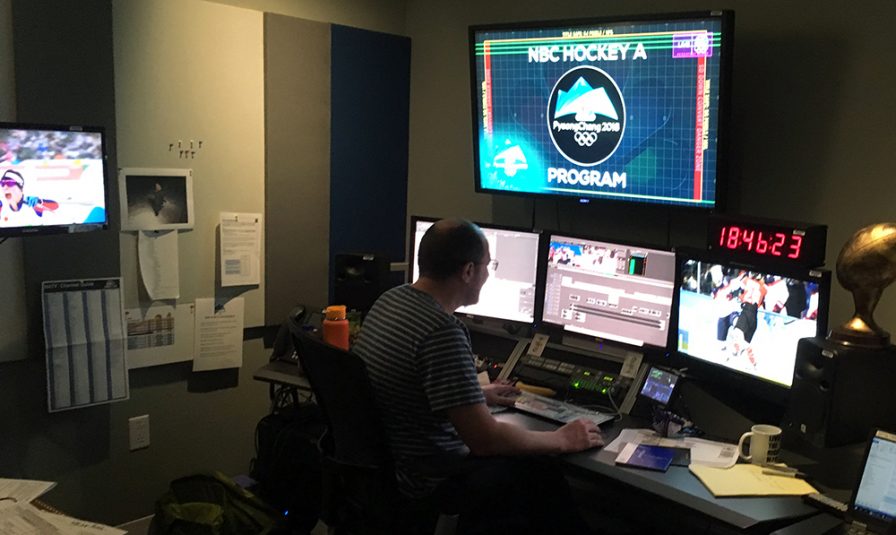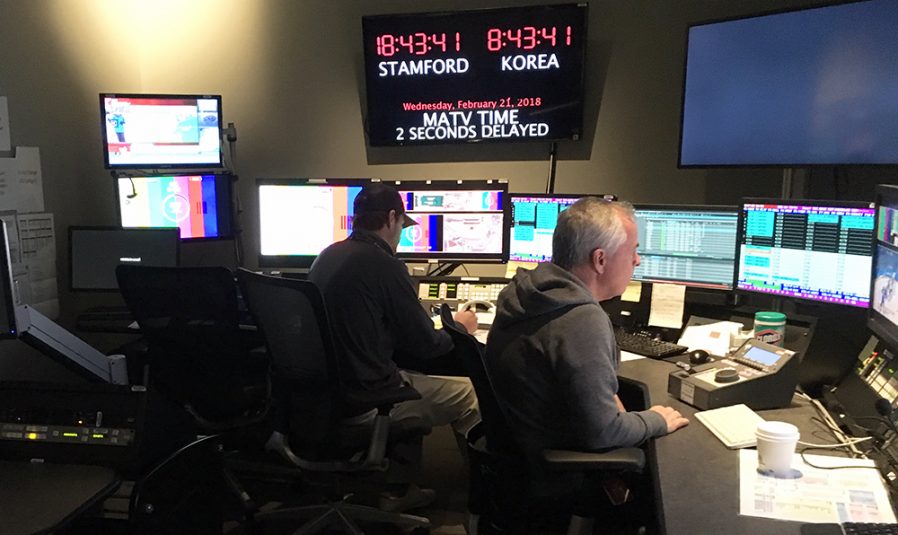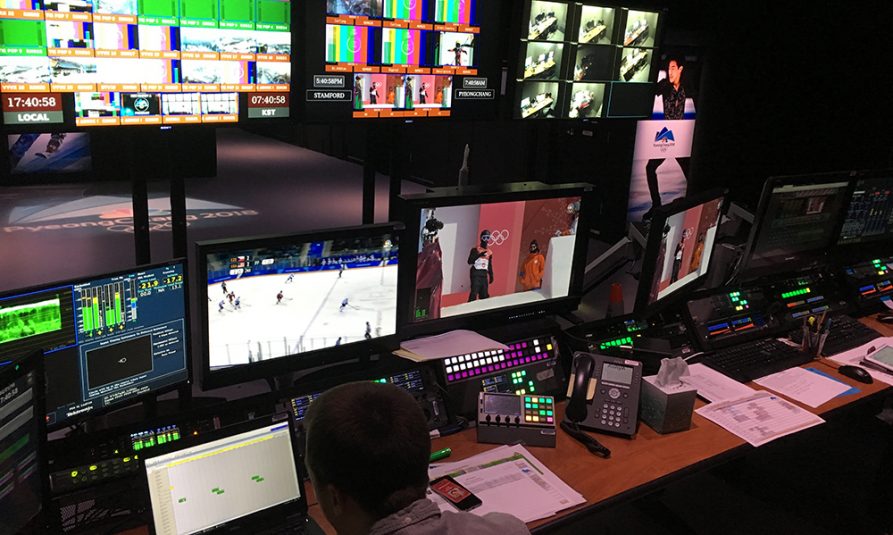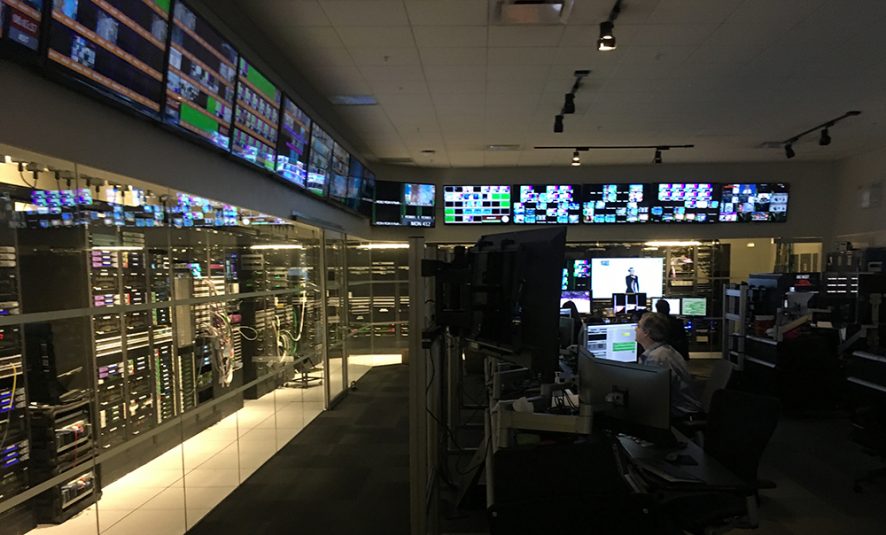Stamford Spotlight, Part 1: NBC Olympics’ At-Home Production Goes Full-Throttle 24/7 for PyeongChang 2018
The operation at NBC’s SPOC in Stamford is bigger than ever
Nearly 7,000 miles separate PyeongChang from Stamford, CT, but, for the past three weeks, the two have been attached at the hip for NBC’s largest and most complex Winter Olympics production to date. The at-home operation at the NBC Olympics Sports Production Operations Center (SPOC) in Stamford is bigger than ever before and has become a truly 24/7 operation, with crew members literally exchanging seats at shift change. Although at-home efforts do reduce cost and travel, NBC is more focused on how the expanded use of its Stamford facility has boosted its production capabilities and quality for PyeongChang 2018.

NBC Olympics’ leaders in Stamford: (from left) Stacey Georgiou, Tim Canary, Ken Goss, and Tom Popple
“The further expansion of our [at-home] production has been a major next step forward for us,” says Tim Canary, VP, engineering, NBC Olympics and NBC Sports Group. “We are doing more and more here without adding substantial amounts of people. When you look at [departments] like our Highlights Factory or the Off-Tube [commentator operation], we are doing a lot more compared with Sochi with basically the same number of people. It’s not just the technology that makes that possible but also the people and the level of consistency we’ve had here year after year.”
During the Games, more than 1,000 people have worked at SPOC on the PyeongChang Olympics. With more than 2,400 hours of total multiplatform coverage (roughly the number of hours for Sochi and Vancouver combined) and 10 days of 24-hour linear-TV programming, the SPOC has been a pressure-cooker of activity.
The facility is running six active control rooms (in 24/7 operation on most days), as well an additional truck parked outside for NBC’s 4K coverage. Also returning to Stamford for PyeongChang 2018 are the Off-Tube announce-booth setup (featuring eight temporary commentary booths in Studio 4), the Highlights Factory and Streaming Factory operations, Broadcast Operations Center (BOC) and Transmission, and a few newcomers, such as the Enhanced Viewing Experience room. Throw in an army of Avid Edit and Pro Tools suites, as well as all of NBC Olympics’ EVS servers and MAM ingest channels, and it’s obvious how big the at-home operation is.
“It once again has been a genuine team effort with a phenomenal group of people,” says Ken Goss, SVP, remote operations and production planning. “We’ve been able to plan shifts for the 24-hour operation, so everyone is as fresh as they can be, and it’s been very positive. The entire team has done a great job, and I think everyone here feels that they have contributed to the overall success of the PyeongChang operation. Stamford has truly become a place that you can depend on to be rock-solid week in and week out — and that’s even more valuable during [the Olympics].”
A Sextet of Control Rooms: NBCSN, NEWBERT, 4K HDR, Digital, and More
For Sochi 2014, control rooms were located in SPOC only for curling and Gold Zone production. This year, a total of six SPOC control rooms are serving studios in both Stamford and PyeongChang.
“It’s exponentially bigger this year,” notes Tom Popple, VP, studio operations and facilities, “with all the sports and studio shows coming out of here.”
NBCSN is deploying three crews at PCR4 for its 24-hour days. PCR4 is the production hub for NBCSN’s Coastal Cluster Studio during the daytime in PyeongChang (16 hours per day); Studio 3 in Stamford takes over for the recap show (eight hours per day during PyeongChang overnight). The NBC Coastal Studio has six channels in both directions between PyeongChang and Stamford on a Media Links Frame. All the cameras are shaded at the IBC in South Korea and sent to PCR4, where the show is integrated.
“Going 24/7 was a big deal for us this year, so we worked closely with the rest of our team here to make sure we had everything we would need. We [established] a workflow for the three production crews, when we switch out everyone — producer, director, TD, graphics, and the others — when an event switches over. And it’s worked out great.”
PCR4 also has control of a Calrec RP-1 remote audio-production system (new for this Olympics) to enable A1s to mix locally. In addition, NBC mirrors the teleprompter in both locations: prompting is done locally in PyeongChang and sent over IP to PCR4 for the producer and director to view.
“The Calrec RP1 is definitely one of the biggest changes for us this year,” says Popple. “It gives the A1 the ability to create their own local mix and do the things that you would normally have to submix remotely. That got rid of a lot of extra manpower and wiring. We will continue to use that moving forward.”
In addition, PCR2 handles hockey coverage from the smaller arena in PyeongChang along with SPOC’s Studio 2 for pre/postgame coverage and intermissions. The onsite operation uses NBC’s custom NEWBERT flypack: an Evertz EMR-64 router, Lawo-based audio core, a small intercom system, and an EVS replay unit in six flight cases.
PCR3 and Studio 1 are serving as home for NBC’s Olympic Ice figure-skating program and curling, while PCR8 and Studio 6 handle Olympic Gold Zone.
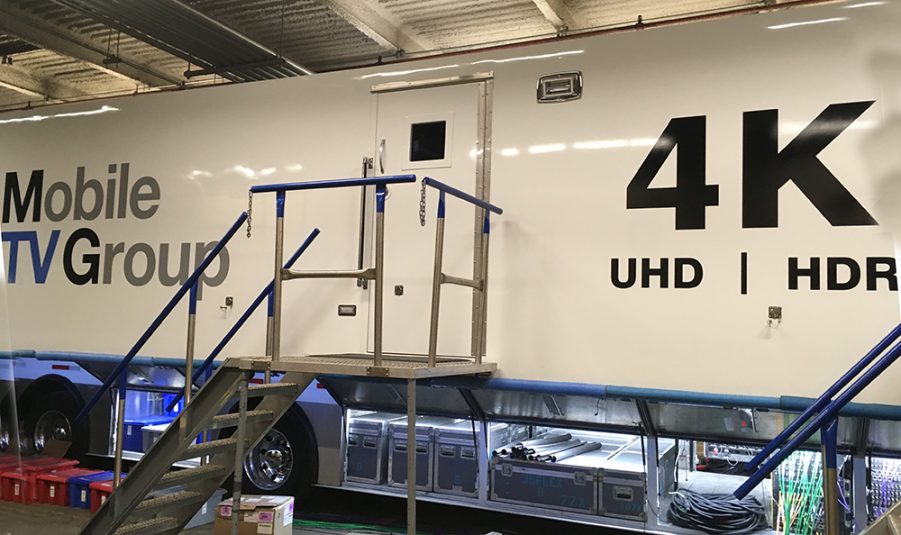
Mobile TV Group’s 39FLEX mobile unit is parked at the truck dock at NBC’s SPOC in Stamford to serve the 4K HDR/Dolby Atmos production of the PyeongChang Olympics.
Mobile TV Group’s 39 FLEX has been pulled up to the truck dock to integrate NBC’s 4K HDR and Dolby Atmos coverage, which is being delivered by OBS and NHK from PyeongChang.
On the digital side, PCR6 is handling daily live news-desk updates for a multitude of platforms. In addition, PCR7 mini control room is serving NBC’s new Enhanced Viewing Experience, which is available for skiing, figure skating, and primetime coverage — and features alternative camera views, behind-the-scenes content, Olympic fact cards, live leaderboards and a Team USA tracker, and marker displays of interactive key moments in the scrubber bar. The operation is split into a primetime team and sport-specific team, which has a remotely controlled Blackmagic switcher feeding an extra Haivision feed from onsite. The PCR7 team composites the switchable feed, and the OBS line is cut into the multi-box frame with changeable graphics behind.
The entire Highlights Factory and Streaming Factory (including digital stream managers and ad inserters) operations are also once again located at the SPOC.
NBC’s PyeongChang and Stamford operations are connected via four 10-Gbps fiber circuits (two for video and audio and two for data/file-transfer needs), and AT&T is onsite monitoring all feeds between the two locations. CLICK HERE for more on NBC Olympics’ sprawling contribution and transmission scheme.
File-Based Workflow Continues To Evolve, Expand
NBC Olympics helped pioneer file-based workflows more than a decade ago, and today its team is continuing to blaze the trail and, in doing so, breaking down the walls between PyeongChang and Stamford operations. NBC has worked with Avid to enhance and expand its MAM system, increasing server capacity and fixing troubleshooting any bugs found during Rio 2016.
In Stamford, NBC is taking a flood of content via its media servers: 28 Avid AirSpeed channels and 60 channels of Harmonic MediaDeck in all. This content is fed to 10 EVS playback rooms (featuring EVS XT3s, with plans to upgrade to EVS XT4Ks in the near future), 60 Avid edit suites, and 20 soft edit workstations, as well as to preditors in the Highlights Factory. In addition, all Pro Tools audio-sweetening sessions are taking place in Stamford this year instead of onsite, as was the case in previous Olympics.
“We’ve grown by leaps and bounds from Sochi in terms of the file-workflow and communication back and forth, and it will absolutely continue to grow in the future,” says Stacey Georgiou, director, post production and graphics. “Since we are doing a lot more [at-home operations] here, our platform is much bigger. A lot of the edit rooms are actually able to stay home now, which means it gets bigger and bigger here. And we also can communicate better and better — both here and in-country.”
Georgiou adds that the workflow among the venues, IBC, and Stamford has become almost seamless, with teams at all three locations pulling and pushing content, thanks to FileCatalyst high-speed file-transfer and more-refined workflows overall.
“Our vendors have really listened to us. When we told them that we wanted to something for this [Olympics], they worked with us to make the product better,” says Georgiou. “Part of the reason our [workflow] has been so good for PyeongChang is, our partners have been so good. To be able to have that seamless communication back and forth constantly means the world to us.”
CLICK HERE for more on NBC Olympics’ file-based workflows.
Off Tube Factory Back in Action
After debuting with one off-tube announce booth at the SPOC for Sochi (for curling) and growing to a whopping 18 for Rio, the Off-Tube Factory is back for PyeongChang 2018 with eight booths inside Studio 4.
NBC has also brought back the Lawo commentary kits and remuxing system created for Rio to serve as the core of this operation. The Off-Tube Factory is being used to call curling, biathlon, and cross-country, as well as for 4K HDR coverage and video description (for Opening and Closing Ceremonies, primetime, and Prime Plus programming).
Play-by-play and color-commentary announcers in each booth are provided with monitors showing the OBS V-and-A feed from PyeongChang, the NBC dirty feed with graphics, and a return feed of the control room. Each booth is assigned a dedicated producer, who communicates between the on-air talent and control room. In addition, a “mini BOC” inside Studio 4 has two audio positions, each with access to the individual mic gains, web-mix output options, and all technical oversight of the eight commentator systems.
29 Months and Counting: Tokyo 2020 Already on the Horizon
The PyeongChang 20018 Closing Ceremony may be just two days away and the Opening Ceremony of the 2020 Summer Games 880 days away, but Tokyo 2020 is already top of mind for the NBC Olympics squad.
“I think we’ll see a major change in everything that ships to Tokyo and some major changes here as well. For this facility, I think the big question between now and Tokyo is what we do in terms of HD or 1080p,” says Canary. “As a group, we keep learning from our successes and mistakes and improving on them. As it’s grown, we have pulled more and more people into that fold and it’s only gotten better.”
Popple adds, “We will get to a place on Tokyo where we have to make a decision about how much we do here. With four control rooms and a truck [dock], there is only so much we can do here. So we are currently looking at the Digital Control Room and maybe making it more user-friendly for [broadcast]. The plant can definitely handle it, but it’s just about getting the muscle together to get us there. At each Olympics, we try out new things, and that just sets the table for the next Olympics.”
It has been a busy month for the Peacock to say the least. The morning after NBC’s Super Bowl LII broadcast, many NBCers took a charter flight from Minneapolis to PyeongChang, and the rest, including Goss, headed directly to Stamford. Through it all, NBC has maintained a sense of sanity, thanks to extensive planning.
“From the Super Bowl right into this, the collaboration has been absolutely incredible, and a lot of it comes down to the preplanning,” he says. “[NBC Olympics SVP/CTO] Dave Mazza and his team, which we are all a part of, lay out a plan and meticulously go through it years ahead of time. Rio was a great [event] for Stamford, and we have just picked up where that left off. We’re already looking forward to Tokyo.”
This is Part 1 of SVG’s three-part series on NBC Olympics’ at-home operation in Stamford, CT. Be sure to check out Part 2, a look inside the 4K HDR and Dolby Atmos operation; and Part 3, a visit to the Highlights Factory.

